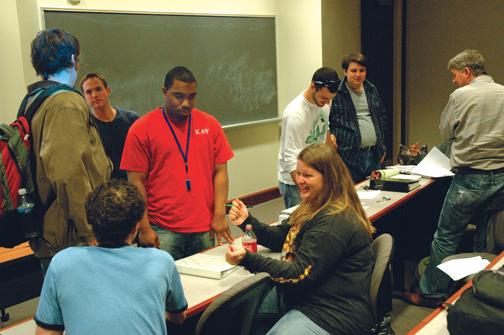Power Projects Teach Thermal/Fluid Concepts

The designer and instructor of the class is Dr. Gary Wilson. “The number-one objective of the course is to integrate heat transfer, thermodynamics and fluid mechanics into the design of a system,” he said. “The second objective is to experience the industrial atmosphere of a large project. Using power plants as the subject for this is a perfect fit.”
Taken in the senior year, the first half of MEGR 3216 is spent reviewing the fundamentals of pipe networks, heat exchangers and other heat transfer components. For the second half of the course, the class of 50 to 70 students is divided into three or four companies. Each company has teams of three to four students who are assigned different elements of the project.
“Each company has an objective and each sub-team has a template of its responsibilities,” Dr. Wilson said. “The students are usually overwhelmed at the beginning, but as they break the project down and get into it they find that it’s manageable. In the end, I think they impress themselves that they pull it off.”
The power plant projects were designed with the help of industry professionals, including AREVA Chief Technical Officer Finis Southworth. “He was very generous with his time and his people’s time in helping develop the projects’ criteria,” Dr. Wilson said.
The project for the fall 2008 semester was the design of a high-temperature gas-cooled nuclear reactor coupled to a hydrogen production facility. Each student company had four teams handling the areas of reactor thermal hydraulics, system cycle design and integration, secondary loop and electricity generation, and hydrogen production design.
“It was a very complicated scenario based on all the systems involved,” Dr. Wilson said. “Each team came up with a different way to produce the hydrogen. They all rose to the challenge.”
For the spring 2009 semester, each student company will be designing a different type of 1,000 megawatt power station. The types of stations include a nuclear-powered pressure-water reactor, a nuclear-powered boiling-water reactor, a coal-fired subcritical vapor-powered plant, and a super-critical fossil fuel plant.
Each company will have teams looking at system cycle design and integration, heat source/steam generation and emissions control, heat exchanger pumps and piping, and heat rejection system and condensers. All of the teams will also have to consider emissions and fuel waste.
“They are getting into the project phase of the course now,” Dr. Wilson said. “I’m eager to see what type of solutions they come up with.”
For more information, contact Dr. Wilson at rwilso32@uncc.edu.